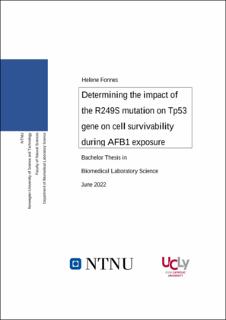| dc.description.abstract | Hepatocellular Carcinoma (HCC) is one of the most frequent and malignant cancers worldwide and is found to be endemic in the same geographically areas as high exposure with Aflatoxin B1 (AFB1). AFB1 is a mycotoxin, naturally occurring as a secondary metabolite produced by microfungi that frequently contaminate foods and feeds.
The complete and exact mechanisms of AFB1 hepatocarcinogenesis have not been fully elucidated, however, one major effect of AFB1 is due to the metabolites created when AFB1 is metabolized in the liver. Indeed, the metabolite AFB1-exo-8,9-epoxide have genotoxic effects, causing DNA adducts that most frequently result in a G>T substitution.
A specific hotspot mutation at the third guanine residue of the codon 249 on the TP53 gene has been identified. The R249S mutation is found in 60 % of patients with HCC in areas where there is high exposure to aflatoxins.
However, these obvious correlations lack direct functional evidence. We therefore developed the project to explore the cell survivability to an AFB1 exposure in the presence and absence of the R249S mutation, and if a long-term treatment with AFB1 would induce this specific mutation in p53 wild type cell lines.
This project used a panel of liver cell lines consisting of HepG2, Hep3B, Mahlavu and HuH7 which all have different mutation status on the TP53 gene.
Our preliminary experiments on HepG2 (p53-WT), HuH7 (p53 overexpression) and Mahlavu (p53-R249S mutation) using MTT assay showed that the R249S mutation doesn’t confer a selective advantage to cells treated with AFB1 at different concentration.
Meanwhile, results from the long-term treatment assay remains currently inconclusive due to the time limit of this project, but it showed a significant difference in tolerance to the AFB1 that was consistent with results from the MTT assay.
This is the first study attempting to give direct evidence between the correlation between the high incidence of the R249S mutation in HCC tumors in the same areas with high aflatoxin exposure. Further research should be encouraged as the impacts of AFB1 on HCC carcinogenesis is a complex picture and an important field of science that needs more research. | |
